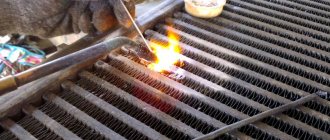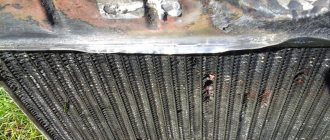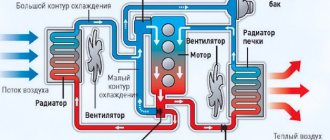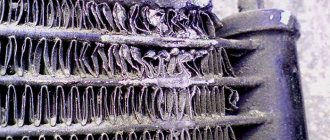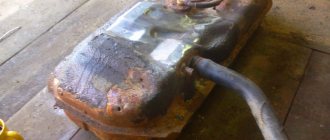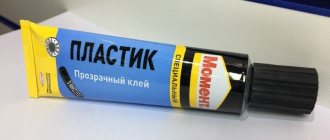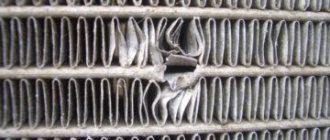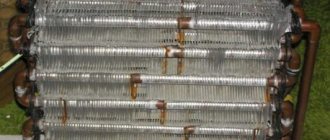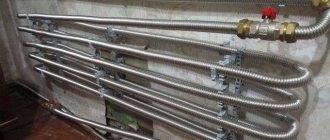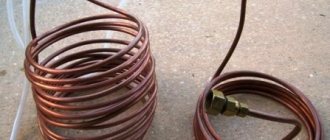If the entire block is not needed, cut the required amount crosswise with a knife.
Any person at least once in his life has been faced with the need to repair radiators, pipes, expansion tank and other components of the heating system. Even twenty years ago, any heating circuit and batteries in it were repaired only by hot welding. Today, the modern market offers a quick and effective way to eliminate leaks and holes in any piece of heating circuit equipment. In this case, you no longer have to use welding at elevated temperatures. Well-known methods have been replaced by a new technology - cold welding for cast iron batteries, bimetallic and aluminum radiators, plastic and steel pipes of the heating system.
Is repair always possible?
A radiator leak detected early is easier to repair because the cause of the failure is a small crack. A defect identified in time is easier to eliminate, and the restored device will last for many more years.
To reinforce the adhesive layer, it is possible to use simple plastic mesh Source Samsvar.ru
Soldering a radiator at home
Soldering cooling system radiators is a classic repair method. It was used at the beginning of the last century. At that time, radiators were made of copper or its alloys (usually brass). Soldering technology was mature at that time. A copper kettle could be repaired in any city. The soldering process is performed at the melting temperature of the solder used. To perform soldering, the following materials and tools are required:
- a powerful soldering iron of 220 Volts (it is better to use a hammer type with a power of 250 or 200 Watts, if not available, at least 100 Watts);
- medium grit sandpaper;
- active flux;
- tin-lead solder POS-60 or POS-40;
- solvent for surface cleaning.
Basic methods for eliminating leaks
Before starting repair work, you should decide on the restoration method. Most often, damage is eliminated using:
- gluing. This method is chosen to eliminate minor cracks. To successfully solve the problem, pay attention to the composition of the glue: the substance must be selected according to the material of which the radiator body is made;
- cold welding. The adhesive mass contains epoxy resin and additives in the form of iron and other compounds. Repairs using cold welding occur efficiently and quickly. Despite the ease of use, a leak can be eliminated in a short time by forming a reliable seam at the crack site.
Methods of use
To repair pipes, you need to prepare everything you need - the welding agent itself, acetone or alcohol, sandpaper, rags and clamps. The method of sealing radiators varies somewhat depending on the type of welding - liquid or plastic. It is important to choose a suitable product that is suitable for pipes under pressure (metal or polypropylene). Next, you need to prepare and mix the material, and you should work faster with liquid products.
Welding application methods:
- simply sealing the defect with a piece of mass, flattened and kneaded with your fingers;
- the use of special fiberglass fabrics, threads for wetting with epoxy, followed by wrapping with rubber, wire or without it;
- gluing onto a large defect covered with a metal patch.
If the leak is strong, you can make the composition even more durable with your own hands. You need to take any aluminum or bronze part, grind it a little over paper, obtaining metal powder. It needs to be added to the epoxy mixture, which is then used to saturate the turns of thread or fabric.
Application of glue
Only two-component adhesive mixtures are suitable for repairing a plastic radiator. They cope well with situations where the crack in the radiator is large enough or it is not possible to connect the parts of the case due to a lack of small fragments. If a small crack is being repaired, simply mix the glue components and apply it to the crack in two layers.
In some cases, a crack appears in a hard-to-reach place. In this case, the sealant is applied along the entire length of the radiator Source Chebo.pro
How to seal a car radiator
For a long time, mustard powder has been a folk remedy for repairing an important device in a car’s cooling system. They poured it into the radiator, and the flow of water quickly spreads inside the case. Under the influence of high temperature, the mustard quickly softened and covered all small and large cracks.
Chemicals based on different components act on the same principle. The advantage of using substances is the rapid elimination of the problem. There are several disadvantages:
- the engine cooling system may completely fail;
- the radiator may become clogged;
- The country of manufacture and the composition of the product are not known, which means there is no guarantee.
Cold welding
This epoxy resin-based adhesive is excellent for repairing any plastic parts - just apply the adhesive and wait until it dries completely. Cold welding can also be used as an additional protective layer over a patch of regular two-part adhesive.
To eliminate a leak at the junction of the pipe, it is best to use cold welding Source B2b-instrument.ru
Advantages and disadvantages
The technology allows you to eliminate pipe leaks with high reliability. This procedure is safe to perform, which cannot be said about conventional welding. Other benefits are:
- convenience, ease of the technique even for beginners;
- excellent seam quality, which depends mainly on the type of material, and not on the speed of work;
- no need to purchase special tools, equipment, machinery and expensive materials;
- minimum energy consumption;
- fire, anti-explosion properties of epoxy;
- low cost of repairs;
- Availability of cold welding - adhesives are sold in any store.
The technology also has disadvantages. Welding of this type is not designed for too high loads - pressure, high heat. Therefore, if there is a serious defect in a pipe or radiator, it is better to use hot welding or replace the area completely. It is important to follow the preparation measures - otherwise the quality of the weld will decrease. The durability of cold welding is lower than that of standard welding - repaired pipes will not last for many years, but will require new repairs. In fact, such repairs are considered by specialists to be a temporary measure.
Internal radiator repair using chemicals
There are special compounds on sale that can be used to restore the tightness of the radiator without extra effort. This chemical is a powder poured inside the radiator. Under the influence of water and high temperature, the particles of the composition swell and seal minor cracks in the body. In auto shops, this product is known as “powdered radiator restorer.”
Appearance of a sealing patch made from two-component adhesive Source Drive2.ru
The main reasons for the loss of radiator tightness, signs, repair features
Loss of tightness of the radiator of the cooling system may be due to the following reasons:
- Natural wear and tear. The approximate lifespan of a radiator is about 10-12 years. As the device wears out, its internal working surface becomes covered with a layer of scale and deposits formed as a result of chemical and thermodynamic processes. The walls of the radiator plates and tubes become thinner. Since the liquid in the device is under pressure, microcracks are possible, as a result of which the liquid begins to leave the system.
Considering that the sizes of microcracks are small, a strong leak is not observed in this case. Wet traces of leakage may disappear after cooling the engine and antifreeze. It is advisable to immediately detect the consequences and place of fluid leakage. The sooner repairs are made in this situation, the less damage will have to be repaired. Can be successfully repaired by cold welding .
- Filling the cooling system with water. Freezing in the cold season. If there is a slight leak of antifreeze, many drivers add limited amounts of water to the system. During the warm season of vehicle operation, the number of such top-ups can be large. As a result, the concentration and characteristics of antifreeze change. In winter, even at slightly below zero temperatures, it can freeze. In this case, volume expansion occurs. The radiator may “break”.
The resulting crack is usually large in size. It can occur at the junction of plastic and metal radiator elements. In most cases, such damage is difficult to repair.
- Filling the cooling system with low-quality antifreeze. Overpressure. In most modern engines, the coolant is under pressure. At the same time, the boiling point of antifreeze increases to more than 100 degrees Celsius. This allows you to increase the efficiency of the engine. If low-quality antifreeze is poured into the system, it may boil at a lower temperature. This may damage the radiator. It may be small. In such cases, it is better to use the soldering repair method, as it provides better performance in terms of resistance to increased pressure. Soldering is easy to do at home .
- Mechanical damage . This malfunction may be due to:
- foreign objects entering the radiator area;
- road accident;
- destruction of fan blades;
- poor quality repairs.
Depending on the location and size of the damage, cold welding and soldering methods can be used for repairs.
Repairing cast iron and other types of radiators
Working with radiators is similar to sealing defects on pipes. The surface is cleaned and degreased. You can use alcohol for this purpose, applying it with a cotton swab. Next, take a ball of resin approximately 2 cm in diameter, knead it, mixing the components. Press the resin to the damaged area, smooth it out, and hold it with a rag or clamp.
Usually 30-40 minutes are enough for polymerization, but it is better to use the battery after a day, not earlier. Naturally, the water supply must be turned off before repairs. If you need to remove a fistula, you need to take fiberglass and a liquid solution, wrap the area and seal it securely.
Cold welding is an excellent temporary measure until the end of the heating season. It will help eliminate pipe or radiator leaks quickly and without hassle!
How to detect a leak?
If the engine begins to overheat frequently, and the coolant that was recently poured into the tank quickly disappears somewhere, it is necessary to urgently diagnose the radiator for holes. To find out where the hole is, you need to dismantle the radiator and carefully inspect it.
But it is not always possible to find the hole visually. Then you should use other diagnostic methods. So, how to check a radiator for leaks:
- To do this, all openings of the device are closed with plugs.
- The part is then lowered into a suitable container of water.
- Next, you need to observe - if bubbles appear, then there is a breakdown in those places on the radiator.
Diagnosing leaks from the pipes or from the heat exchanger itself will not be a problem. But if no fluid leaks are observed, and the temperature of the antifreeze or antifreeze quickly rises to critical values during movement, then it is much more difficult to find out the cause. This situation usually occurs when there is not enough coolant or the radiator is not working efficiently. If traces of coolant are found under the hood, it is necessary to urgently repair the radiator.
Questions and answers
Most often, sealant solves the problem of radiator leaks. Each product must contain instructions for use; it is recommended that you read it before purchasing.
Is it possible to eliminate leaks in the cooling system yourself?
Radiator cooling and heating systems sometimes leak. This is due to significant temperature changes, which contribute to the occurrence of heat-shrink processes in the thin walls of the pipes. The result is the formation of microcracks, through which liquid begins to escape. It is best to replace the broken element. But if this is not possible, you should use a sealant.
There is also a proven method - buy a pack of dry mustard. When added to antifreeze, it can temporarily reduce or even eliminate minor leaks.
But after that you need to thoroughly rinse the system, since the powder clogs both the cracks and the cooling channels themselves, radiator pipes and the stove.
How to use it correctly?
The approximate steps for applying any sealants are as follows:
- You can unscrew the radiator cap only with the engine turned off and slightly cooled.
- Next, a certain amount of sealant is poured or poured into the radiator, which is indicated in the instructions.
- The engine must be started and allowed to idle for 2-3 minutes, then it turns off. After a while, you need to check for leaks with the engine turned on again.
If the leak remains, then in this case there are two options:
- the product was not used correctly;
- The hole diameter is large and the composition cannot cope with it.
What to do if sealant clogs the cooling system?
The sealant can clog the cooling system, so its use should only be done when absolutely necessary. If trouble has already occurred and the engine overheats, since the circulation of antifreeze is small, you can use a sealant. But after a while it will clog the system, so it will need to be flushed.
We must not forget that after cleaning, the sealant will be completely washed out, and the holes that it sealed will again let liquid through, so it is necessary to prepare for repairs. There are both branded products for washing sealant and traditional methods. In the first case, the product costs money, in the latter it is almost free, but the effectiveness is questionable.
Branded drugs:
- HI-Gear Radiator Flush;
- LIQUI MOLY Kuhler-Reiniger;
- K2 Radiator Flush;
- 3ton TP-302.
Traditional methods include vinegar, Fanta drink, and baking soda.
Elimination of fistula
For any breakdown there are a number of reasons accompanying it. A fistula on heating system pipes or on a radiator is no exception. If a small brown spot appears on the elements of the heating network, you should not think that it is paint coming off. In fact, this is the beginning of an often irreversible process, but knowing how to repair a fistula in a cast iron battery, you can stop the destruction and extend its service life. Causes of corrosion:
- Taking into account the frequent increases in the cost of utilities, some craftsmen are cunning and, in order to save energy, connect a neutral cable to the heating circuit. The currents that begin their “journey” through the pipes through the coolant are what cause the formation of corrosion. You can identify a dishonest neighbor if there are several fistulas and they appear with a certain regularity. Calling the appropriate service to identify the intruder and repairing cast iron batteries yourself will help save the situation.
- Too much acidity of water can harm even corrosion-tolerant cast iron.
- The batteries have expired or deposits on the battery walls have damaged the metal. In this case, even a small fistula or crack under the influence of water pressure can cause the battery to burst and a stream of hot water to flow from it.
Any of the options requires urgent intervention. If the cast iron battery leaks only slightly, then you can do without disconnecting the circuit and dismantling it. A clamp can save the situation. If the water only drips, then a one-sided clamp will do, but if it runs in a thin string, then it is better not to risk it and use a double-sided clamp.
In the event that the coolant ruptures the place where the fistula was located, the question immediately arises whether it is possible to weld a cast iron battery . As a rule, cold welding becomes an emergency solution, but even if it has restored the tightness, it is necessary to call specialists from the heating network to check the condition of the heating system.
Features of soldering aluminum radiators
Modern cars mainly use aluminum radiators. Aluminum material does not solder well. Almost instantly after stripping, it becomes covered with a layer of oxide, which prevents soldering. On radio markets you can find a special active flux for aluminum. It greatly simplifies the soldering process.
You can use small metal shavings when soldering. It is applied to the repair site mixed with flux. During the application of solder, shavings scratch the surface of the aluminum. Under the layer of flux, the metal does not have time to oxidize, and soldering is successful. Please note that aluminum is a soft material, so you should not apply excessive force to avoid damaging the radiator.
Soldering the radiator: method 1
It includes the following steps:
- Surface preparation. This process must be done carefully. It consists of cleaning the treated area from all dirt and paint residues. Clean the aluminum surface using emery cloth and solvent. Preparation also includes degreasing the treated area (for this, preparations containing alcohol are used), as well as wiping the metal dry.
- Preparation of iron rosin flux. To do this, the crucible is placed on a gas stove and heated. You can heat it with a blowtorch. A piece of rosin is placed in a heated crucible. It needs to be completely melted. Next, add iron filings little by little and immediately stir the mixture. The ratio of rosin and sawdust should be 2:1.
- Applying flux to the prepared area. The solution is applied so that the desired part of the radiator surface is completely covered. Otherwise, oxygen will have access to the aluminum, and the hole will not be soldered well. At the end, the entire soldering surface should be under a layer of flux.
- Soldering. It involves introducing solder into a liquid flux environment. You need to take small portions of solder onto the soldering iron. Solder is applied to the soldering area so that it is under the flux layer. At the same time, perform circular movements. During these movements, the soldering iron constantly dislodges some particles of solder. The displacement of iron particles leads to the destruction of the oxide film. Rosin prevents air from penetrating the aluminum.
This method should be used to eliminate small defects. If the damage is large, then you can only solder the radiator using homemade flux.
Temperature indicators of the mixture
Depending on the exact composition and specific manufacturer, the temperature range of welding applications can vary greatly. Most products can withstand freezing, for example, Mastix glue will not lose its properties even at 60 degrees. The overwhelming majority of cheap epoxies only work up to +150 degrees, so they can be used for welding radiators and heating pipes (heating networks usually operate at +95...+110 degrees).
Better quality products can withstand up to +260 degrees, but there are also high-temperature mixtures - they are used even in extreme conditions (up to +1300 degrees). Although there is no point in spending money on purchasing such products, you can buy a simple low-temperature composition.
What is the difficulty of soldering aluminum?
This metal quickly reacts with oxygen and any acids. Most often, an aluminum radiator interacts with oxygen. As a result, the metal surface is oxidized and covered with a thin layer of aluminum oxide. It is also known as “oxide film”. This layer evenly covers the entire surface of the product.
On the one hand, this film is useful, because it eliminates any possibility of contact of pure aluminum with oxygen and all other chemical elements or substances. That is, it is a kind of protective barrier. However, this barrier does not allow for high-quality soldering, because the solder must be in direct contact with the aluminum.
Causes of damage
There are not many reasons that cause problems with radiators. All of them can be divided into two types. These are mechanical reasons and natural wear and tear, which contribute to various damages that compromise the integrity and tightness of the device. Even a small stone that accidentally flew out from under the wheels can cause a breakdown and leakage of the radiator.
But sometimes auto mechanics are faced with another factor - head-on collisions with other cars. Even a minor blow to the bumper is enough to cause a breakdown. In addition, mechanical reasons include various repair work that is done by novice car enthusiasts. This often leads to damage to important parts and components of the device.
Corrosion processes, as well as natural wear and tear, are the second group of reasons that cause radiator leaks. It must be remembered that even minor scratches or chips can very quickly turn into a source of active corrosion. If you do not pay attention to this problem in time, then as a result of the destructive process, a hole will appear through which the coolant will flow out of the system. Minor cracks are quite difficult to detect. But if you get down to business seriously, then often all such damage can still be found.
These are two groups of typical reasons that can provoke depressurization and damage to the heat exchanger and subsequently coolant leakage. In addition, there are also some troubles during operation that can cause improper circulation of antifreeze in the system.

